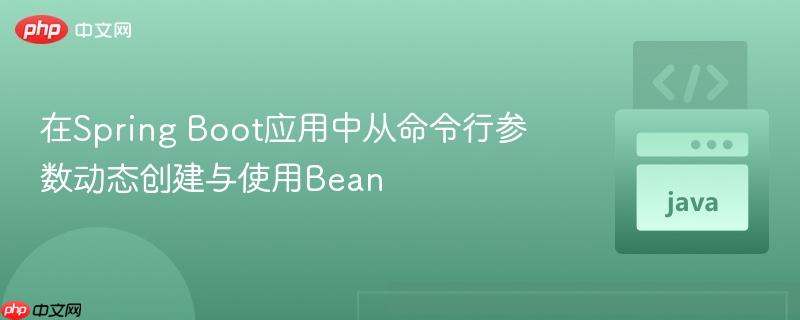
本文详细介绍了在spring boot应用中,如何利用`applicationrunner`获取命令行参数,并通过`genericapplicationcontext`动态地将这些参数注册为spring bean。教程涵盖了bean的注册方法、在代码中如何使用这些动态bean,以及如何通过`@springboottest`进行有效的测试,确保动态bean机制的正确性与可用性。
在Spring Boot应用开发中,尤其是在构建批处理任务或需要运行时动态配置的场景下,我们常常需要从命令行接收参数,并将这些参数作为应用程序的配置或数据来源。一种高效且符合Spring IoC容器管理思想的方式,是将这些命令行参数动态地注册为Spring Bean,从而使其能够被其他组件自动注入和管理。本文将详细阐述如何在Spring Boot应用中实现这一机制。
要实现从命令行参数动态创建Bean,我们需要结合使用Spring Boot提供的两个关键接口和类:
以下是在Spring Boot应用中从命令行参数动态注册Bean的具体步骤。
首先,我们需要创建一个实现ApplicationRunner接口的Spring Boot主应用类,并注入GenericApplicationContext。在run方法中,我们可以通过ApplicationArguments获取到原始的命令行参数。
import org.springframework.beans.factory.annotation.Autowired;
import org.springframework.boot.ApplicationArguments;
import org.springframework.boot.ApplicationRunner;
import org.springframework.boot.SpringApplication;
import org.springframework.boot.autoconfigure.SpringBootApplication;
import org.springframework.context.support.GenericApplicationContext;
@SpringBootApplication
public class MySbApp implements ApplicationRunner {
public static void main(String[] args) {
SpringApplication.run(MySbApp.class, args);
}
@Autowired
private GenericApplicationContext context; // 注入GenericApplicationContext
@Override
public void run(ApplicationArguments args) throws Exception {
String[] arguments = args.getSourceArgs(); // 获取原始命令行参数
System.out.println("检测到命令行参数:");
for (String arg : arguments) {
System.out.println(" - " + arg);
// 步骤二:在这里注册Bean
// ...
}
}
}在ApplicationRunner的run方法内部,遍历获取到的命令行参数,并使用GenericApplicationContext的registerBean方法将它们注册为Spring Bean。registerBean方法有多个重载形式,最常用的一种是 registerBean(String beanName, Class<T> beanClass, Supplier<T> instanceSupplier)。
import org.springframework.beans.factory.annotation.Autowired;
import org.springframework.boot.ApplicationArguments;
import org.springframework.boot.ApplicationRunner;
import org.springframework.boot.SpringApplication;
import org.springframework.boot.autoconfigure.SpringBootApplication;
import org.springframework.context.support.GenericApplicationContext;
@SpringBootApplication
public class MySbApp implements ApplicationRunner {
public static void main(String[] args) {
SpringApplication.run(MySbApp.class, args);
}
@Autowired
private GenericApplicationContext context;
@Override
public void run(ApplicationArguments args) throws Exception {
String[] arguments = args.getSourceArgs();
System.out.println("检测到命令行参数并尝试注册为Bean:");
for (String arg : arguments) {
System.out.println(" - 注册Bean: " + arg);
// 示例:将每个参数注册为一个Object类型的Bean,参数值作为Bean名称
// 你可以根据实际需求创建更具体的Bean类型和实例
context.registerBean(arg, Object.class, () -> new Object());
}
}
}在上述示例中,我们为每个命令行参数注册了一个Object类型的Bean。在实际应用中,你可以根据参数的含义创建更具业务逻辑的Bean类型,例如,如果参数代表一个配置值,你可以创建一个包含该值的配置Bean。
一旦Bean被动态注册到Spring容器中,它们就可以像其他Spring Bean一样被注入和使用了。
你可以在任何需要访问这些Bean的地方注入ApplicationContext,然后通过Bean的名称(即命令行参数的值)来获取它们。
import org.springframework.beans.factory.annotation.Autowired;
import org.springframework.context.ApplicationContext;
import org.springframework.stereotype.Component;
@Component
public class MyService {
@Autowired
private ApplicationContext applicationContext;
public void doSomethingWithDynamicBeans() {
try {
Object fooBean = applicationContext.getBean("foo");
System.out.println("通过ApplicationContext获取到动态Bean 'foo': " + fooBean);
// 对fooBean进行操作
} catch (Exception e) {
System.out.println("Bean 'foo' 不存在或获取失败: " + e.getMessage());
}
}
}如果Bean的名称是已知的或可预测的,你可以直接使用@Autowired结合@Qualifier注解进行注入。
import org.springframework.beans.factory.annotation.Autowired;
import org.springframework.beans.factory.annotation.Qualifier;
import org.springframework.stereotype.Component;
@Component
public class AnotherService {
@Autowired
@Qualifier("bar") // 假设命令行参数中包含 "bar"
private Object barBean;
public void processBarBean() {
if (barBean != null) {
System.out.println("通过@Qualifier注入的动态Bean 'bar': " + barBean);
// 对barBean进行操作
} else {
System.out.println("Bean 'bar' 未被注入。");
}
}
}为了确保动态Bean注册机制的正确性,我们需要编写测试用例。Spring Boot的@SpringBootTest注解提供了一个方便的方式来模拟命令行参数。
package com.example.demo; // 确保包名与主应用类一致
import static org.junit.jupiter.api.Assertions.assertNotNull;
import org.junit.jupiter.api.Test;
import org.springframework.beans.factory.annotation.Autowired;
import org.springframework.beans.factory.annotation.Qualifier;
import org.springframework.boot.test.context.SpringBootTest;
import org.springframework.context.ApplicationContext;
// 使用 @SpringBootTest(args = {"param1", "param2"}) 来模拟命令行参数
@SpringBootTest(args = {"foo", "bar"})
public class DynamicBeanCreationTest {
@Autowired
private ApplicationContext applicationContext; // 注入ApplicationContext用于获取Bean
// 注入我们之前创建的MyService或AnotherService,以便测试它们是否能正常工作
@Autowired
private MyService myService;
@Autowired
private AnotherService anotherService;
@Test
void testBeansRegisteredViaApplicationContext() {
// 验证通过ApplicationContext获取Bean
Object fooBean = applicationContext.getBean("foo");
assertNotNull(fooBean, "Bean 'foo' 应该被注册并存在");
Object barBean = applicationContext.getBean("bar");
assertNotNull(barBean, "Bean 'bar' 应该被注册并存在");
// 验证其他服务是否能正常使用这些动态Bean
myService.doSomethingWithDynamicBeans(); // 应该能找到 'foo'
}
// 假设我们有一个服务直接通过@Qualifier注入这些动态Bean
@Autowired
@Qualifier("foo")
private Object fooAutowiredBean;
@Autowired
@Qualifier("bar")
private Object barAutowiredBean;
@Test
void testBeansAutowiredViaQualifier() {
// 验证通过@Autowired和@Qualifier注入Bean
assertNotNull(fooAutowiredBean, "Bean 'foo' 应该能够被自动注入");
assertNotNull(barAutowiredBean, "Bean 'bar' 应该能够被自动注入");
anotherService.processBarBean(); // 应该能找到 'bar'
}
}通过结合ApplicationRunner获取命令行参数和GenericApplicationContext进行程序化Bean注册,我们可以在Spring Boot应用中实现高度灵活的运行时配置。这种方法使得应用能够根据启动时的外部指令动态地构建其组件,从而提高了应用的适应性和可配置性。同时,利用@SpringBootTest的args属性,我们可以方便地对这一机制进行单元和集成测试,确保其健壮性。
以上就是在Spring Boot应用中从命令行参数动态创建与使用Bean的详细内容,更多请关注php中文网其它相关文章!

每个人都需要一台速度更快、更稳定的 PC。随着时间的推移,垃圾文件、旧注册表数据和不必要的后台进程会占用资源并降低性能。幸运的是,许多工具可以让 Windows 保持平稳运行。




Copyright 2014-2025 https://www.php.cn/ All Rights Reserved | php.cn | 湘ICP备2023035733号